 |
Site created 12/15/97.

page created: 11/23/10
 Barrie Maxwell - Main Page |
Classic Reviews Round-Up #65 and New Announcements
Welcome to the latest Classic Coming Attractions column. This time I have 14 DVD reviews for you: Oil for the Lamps of China, High Wall, Crack-Up, Stranded, the Torchy Blane Collection, and Between Two Worlds from the Warner Archive; Roy Rogers: King of the Cowboys, Branded: Season One, and Branded: Season Two from Timeless Media Group; Four in a Jeep, Hell Is Sold Out and Apache Rifles from VCI; Monte Walsh from Paramount; and Douglas Sirk: Filmmaker Collection from TCM/Universal. There are also 5 Blu-ray reviews: White Christmas from Paramount; and Mutiny on the Bounty, The Maltese Falcon, The Treasure of the Sierra Madre and Ocean's 11 from Warner Bros. The usual round-up of new classic release announcements is included and the classic announcements database has been updated. I hope you'll enjoy this latest installment. Classic DVD Reviews Before I saw the 1935 film Oil for the Lamps of China many years ago on TV, its title was always one that intrigued me. The fact that it was made by my favourite studio for classic titles - Warner Bros. - and that it starred the ever-reliable Pat O'Brien were another couple of factors on the positive side of the ledger. 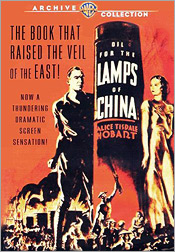
When I finally did see the film, I was pleased to find that it lived up to its promise and then some - the latter mainly due to a very appealing and sympathetic performance by Josephine Hutchinson. Warners has now made the film available as part of the Warner Archive and revisiting it recently was a pleasure. Based on the bestseller of the same title by Alice Tisdale Hobart, the film focuses on Stephen Chase (O'Brien) who is a key man for the Atlantis Oil Company as it tries to expand its business into the burgeoning Chinese market. Chase is a company man, placing the company's interests above everything else in his life. That loyalty causes him to abandon his wife during childbirth, sees him sacrifice a friendship, and in the end cause the death of a fellow employee as well as nearly losing his own life. His expectation is company loyalty towards him, but it's increasingly an expectation that seems in jeopardy. Through it all, Chase has the love and support of his wife (Hutchison), a woman whom he initially married as a compromise - the marriage essentially a business arrangement of mutual benefit. The film treads a very fine line between being pro- and anti-business, and does so successfully. The basics of the plot suggest the former, but the sentiment projected is definitely the latter. Both O'Brien and Hutchison offer well-rounded portrayals that render their characters as warm and likable people, yet realistic ones with human failings to which one can relate. A fine supporting cast of stock Warner players including Donald Crisp, Lyle Talbot, Arthur Byron, and John Eldridge provides comfortable backup. Warners' has done a nice job in creating a Chinese atmosphere and director Mervyn LeRoy moves the story along briskly. It's in the latter respect that the film falters at all. There is an epic sense to the story that would have benefited from a more expansive screenplay. At times one wishes that things didn't move quite so quickly, with at least a couple of the plot transitions being too brusquely resolved. The Warner Archive release is full frame as originally released. The image offers very nice contrast but is somewhat soft overall. Blacks are quite deep and shadow detail is acceptable. Modest grain is evident throughout. There are plenty of nicks and speckles, but overall the disc offers a quite satisfactory experience. The mono sound is clear although minor hiss is certainly present. The only supplement is the theatrical trailer. Recommended. After good success with The Rifleman which ran for some 168 half-hour episodes over five seasons from 1958 to 1963, Chuck Connors had a more modest western success with Branded. That series ran for two seasons on NBC beginning in January 1965 and ending in April 1966. All 48 half-hour episodes are available on DVD in two 3-disc box sets from Timeless Media Group - Branded: Season One and Branded: Season Two. 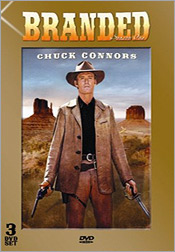 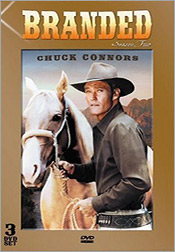
The premise of the series has Connors playing Jason McCord, a former cavalry officer branded a coward for supposedly deserting the field of battle at an Apache Indian massacre at Bitter Creek where all the rest of his company was killed. Stripped of his rank and thrown out of the Cavalry, McCord roams the west dealing out justice for others. It gives little away to reveal that McCord was in reality no coward, but a principled individual whose actions at Bitter Creek were taken to protect the reputation of a senior officer whose judgment had become questionable. Even when McCord has opportunities to clear his name officially, he refuses to take them for that reason plus the desire to maintain the peaceful co-existence between Whites and Indians that has developed in the time after Bitter Creek. While the early episodes deal specifically with McCord's reputation through plot variations related to revealing his supposedly cowardly actions or clearing his name, the series eventually settles into a pattern of McCord finding himself in situations where he can provide assistance. In so doing, the emphasize shifts to reinforcing the concept of principled individual he really is, rather than dwelling on the consequences of being the coward he's been branded. Some of the episodes, particularly in the second year, find McCord acting as an agent for President Grant, a clear indication that people at a high level know the real truth of McCord's actions at Bitter Creek and thus representing an unofficial vindication for him. Connors gives the McCord character considerable stature as a result of his positive actions, not to mention the presence accorded by his physical stature. Branded doesn't have quite the allure and humanity of The Rifleman and pretty much exhausts its welcome by the end of its final season, but it is in general a satisfying program that seldom fails to generate at least some interest in each of its episodes. A fine roster of guest stars is a definite plus (Alex Cord, Burt Reynolds, Rod Cameron, John Carradine, Cesar Romero, Marie Windsor, Lee Van Cleef, Pat O'Brien, Michael Rennie, Beau Bridges, among others). The DVD releases are distributed by Timeless Media with King World holding the rights to the show. The episodes were originally shown full frame and that's how they're presented on the DVDs. Unfortunately the image is merely passable, looking quite soft throughout. The contrast isn't too bad, but black levels are weak. There are numerous speckles and scratches in evidence. Most of the first season was in black and white with colour being used throughout the second season. The colour episodes are rather pale. The mono sound sports some minor hiss, but dialogue legibility is fine. The images do not bear screening on larger displays, but are best viewed on screens less than 40". The first season supplements include a Rifleman episode (Day of the Hunter), a Four Star Playhouse episode from 1955 that has Connors in a supporting role to David Niven (Vote of Confidence), and a short video biography of Connors. The second season supplements consist of a revealing and lengthy (58 minute) video interview with series creator Larry Cohen. It's broken up into three parts, one on each of the three discs. Recommended for Branded fans, otherwise a rental (with the caveat on screen size for viewing). Roy Rogers has never received his proper due on DVD. Unlike the fine transfers that generally are available for the Gene Autry and Hopalong Cassidy films, Roy's films have tended to appear in truncated versions with passable transfers at best. A recent release from Timeless Media Group - Roy Rogers: King of the Cowboys - is a case in point. 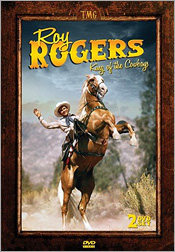 The release is a 2-disc set that contains 5 Rogers movies on one disc and 10 half-hour programs from TV's The Roy Rogers Show on the other disc. The movies are all Republic productions: Apache Rose (1947), The Arizona Kid (1939), Bells of San Angelo (1947), Song of Arizona (1946), and Sheriff of Tombstone (1941). The TV shows are: Ranch War, Double Trouble, And Sudden Death, Bullets and a Burro, Bad Neighbors, Cold Power, Fishing for Fingerprints, Dead End Trail, The Set-up, and Empty Saddles (1952-56). The selection of material in the set is not bad, as most of the programs are average or better in comparison to other B-westerns or early TV western series of a similar vintage and nature. All are in black and white except Bells of San Angelo which was originally made in Trucolor. Apache Rose was also made in Trucolor, but the version here is in black and white. As one might expect when you try to squeeze 5 hours of material onto a single disc, the DVD presentations from Timeless are passable at best, with the TV series' episodes generally looking slightly stronger than the feature films. Some of the movies lack the original opening Republic logos. All are full frame as originally made, and all look washed out and are riddled with speckles and scratches. Viewing on mid-to-large size screens is not advisable. Each has a new colour 30-40 second video introduction featuring an unidentified speaker. The versions of the films are all edited with the exception of Bells of San Angelo. The others lack anywhere from a couple of minutes of their original running time (Sheriff of Tombstone) to as much as 18 minutes (Apache Rose). At least one of the TV episodes is edited too. The mono sound is workable, but there's plenty of hiss and some distortion. Each disc contains a 4-minute video biography of Roy Rogers as a supplement. Narcosynthesis seemed to be a topical procedure for mental cases in the late 1940s. At least, that's the impression I got after viewing MGM's High Wall (1947) and RKO's Crack-Up (1946) back to back. 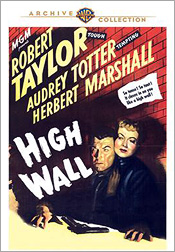 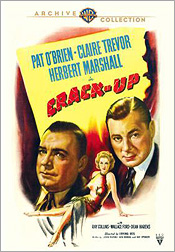 Both films noir are available from the Warner Archive. Each film highlights the procedure (in which narcotics are used to induce or heighten the effectiveness of hypnotic states) as part of its plot, with Robert Taylor being the subject in High Wall and Pat O'Brien in Crack-Up. In High Wall, Taylor is an ex-soldier suffering from wartime head trauma that continues to make him subject to disorientations and blackouts. He believes he has strangled his wife during one such blackout and ends up in a psychiatric ward. There, a sympathetic ward doctor (Audrey Totter) helps Taylor to realize that he may not be responsible for the killing at all, but rather a convenient patsy for the real killer. The film benefits from its strong MGM production value base which director Curtis Bernhardt enhances with a solid noirish look and some effective subjective photography. The forthright approach to Taylor's plight is sharpened by the cold-blooded nature of the killing of his wife and later the murder of a witness at an elevator shaft. Totter and Herbert Marshall provide solid support, but Taylor carries the film in another of the many fine performances that characterized his later career. Pat O'Brien had a lot a fine opportunities at RKO after he left Warner Bros. in the early 1940s. Crack-Up is one of the best. He plays an art critic (and former expert on art forgeries for the army during the war) who breaks into the gallery where he works after experiencing disorientation due to a train wreck. Captured and interrogated by the police, it turns out that the train wreck he claims to have been in never happened. Instead he may have been drugged and had the train wreck idea planted in his subconscious under narcosynthesis, all part of an elaborate effort to hide the fact that forgeries have been substituted for masterpieces at the gallery. O'Brien plays a man suffering from uncertainty very effectively, particularly so during the well-edited sequences that build up to the apparent train crashes. Claire Trevor (an important figure in film noir), Herbert Marshall, and Ray Collins all provide support with an ambiguity that works well to mask their real roles in the film's plot. The film's art focus is a not uncommon one in film noir, here played up by virtue of the tie-in to wartime forgeries and the emphasis on artistic enjoyment highlighted by the divide between elitists and common folk. Coming from "the" noir studio, RKO, it goes without saying that the film is firmly representative of the traditional shadowy and ambiguous noir look and sensibility. The Warner Archive releases of the two films are both quite good. High Wall is a trifle sharper with better contrast, but both offer good shadow detail and a generally above average gray scale representation. Grain is apparent on both, particularly so on Crack-Up. Speckling and some scratches are present on both. The mono sound is clear. Some background hiss can be heard on Crack-Up. Only High Wall has any supplement - its theatrical trailer. Both releases are recommended. Audie Murphy's heroism in World War II opened doors for him in Hollywood and he carved a reasonably successful career in westerns for almost two decades. With no formal acting training, Murphy conveyed quite a relaxed yet convincing character in most of his efforts. His best work was at Universal in the 1950s and early 1960s, but his career declined thereafter. He still appeared in westerns, but they were lesser titles mainly made to fill out the lower half of double bills. Three such titles were made by independent producer Robert Kent and directed by serial and western veteran William Witney - Arizona Raiders, Apache Rifles, and 40 Guns to Apache Pass. 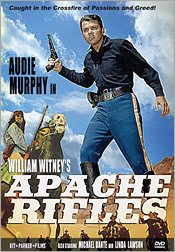
Originally distributed by Fox, Apache Rifles is now available on DVD from VCI courtesy of Kit Parker Films. The basic plot of the film is pretty conventional stuff - the cavalry tries to get the Apaches to return to their reservation when they revolt after white men invade their territory looking for gold. Murphy plays tough but fair cavalry officer Jeff Stanton (not Preston as listed on the DVD packaging) who's somewhat of a racist where Indians are concerned. He eventually comes to recognize the error of his ways after the influence of one of the Apache leaders (Michael Dante as Red Hawk) and a woman missionary who's part Indian (Linda Lawson). Despite the ho-hum story and rather trite dialogue at times, the film does have interest due to Murphy's earnest efforts. William Witney also demonstrates his experience, with interesting camera work that continually provides forward momentum to the action. The Lone Pine locations help a lot too. Look for the likes of L.Q Jones, J. Pat O'Malley, Ken Lynch, and John Archer - all familiar faces who add good colour to the proceedings. VCI's DVD presentation is a superior one. The 1.85:1 anamorphic transfer is above average. It's reasonably sharp and offers generally bright colour with good fidelity. There are some soft passages, but the impact is minor. The image looks quite clean, modest grain is evident, and there's no evidence of edge effects. The mono sound is in good shape. VCI also provides a nice package of supplements. There's a 23-minute making-of documentary that's mainly a video interview with western film historian C. Courtney Joyner - an effort that puts similar efforts on more major releases to shame. Also included are short featurettes on the Lone Pine Museum and on William Witney (mainly an interview with Michael Dante). A stills gallery and trailers for four other westerns rounds out the disc. Recommended for Audie Murphy fans; others should try a rental first. Despite a trailer that declares it's "all new" from Warner Bros., the 1944 film Between Two Worlds is actually a remake of 1930's Outward Bound. That's no problem in this instance, for Between Two Worlds is much the superior version and a film that makes great use of the Warner stock company. 
It's now available from the Warner Archive. Based on a play by Sutton Vane, Between Two Worlds presents us with a group of disparate people aboard a luxury liner bound apparently one-way for the afterworld. As it turns out, each of them has a different afterlife in store for them - a variety of versions of both heaven and hell. The various individuals are played by the likes of John Garfield, Paul Henreid, Eleanor Parker, George Tobias, George Coulouris, Faye Emerson, Sara Allgood, and Dennis King. Acting as steward on the voyage is Edmund Gwenn while Sydney Greenstreet appears as the arbiter bearing each one tidings of their fate. The film features a wartime framing sequence that made the story topical at the time of original release and remains effective today. The film is otherwise a little slow to gather momentum partly due to a rather stereotypical group of characters. By the time we're into the third reel, though, the exceptional work of the cast takes over and immerses us thoroughly in the characters' predicament. Some subtle and realistic transformations occur in the characters and with the appearance of Greenstreet's arbiter, the film becomes a thoughtful meditation on the possible outcomes of people's actions during their lives. The Warner Bros. release has the studio's typically nuanced, unglossy production values, which really lend themselves to the ambiguously normal look of the liner's way-station-like purpose. The Warner Archive release is full frame as originally shown. The image is sharp and offers a nicely detailed gray scale. Shadow detail is very good. There is the odd instance of softness and contrast waver in the foggy ship exteriors, but it's a pleasing effort overall. The mono sound is in good shape and hiss is not an issue. Erich Wolfgang Korngold's evocative score is nicely conveyed. The theatrical trailer is the only supplement. Recommended. The Torchy Blane series consisted of 9 mystery films made during 1937-1939 by the Warner Bros. B unit, with direction by the likes of Frank McDonald (4 films) and William Beaudine (2 films). The two main characters were Torchy, a newspaper reporter, and Steve McBride, a police detective and Torchy's main squeeze. 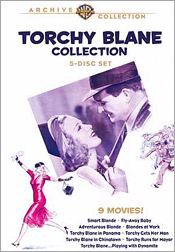
Glenda Farrell and Barton MacLane portrayed the pair in 7 of the films with Lola Lane and Paul Kelly taking over for the 5th entry (1938's Torchy Blane in Panama) and Jane Wyman and Allen Jenkins in the 9th (1939's Torchy Blane… Playing with Dynamite). The films are all between 58 and 63 minutes in length and deliver fine entertainment due to the generally snappy dialogue, brisk if familiar plotting, and the pleasing relationship between the two principal characters. The best of the nine films are Smart Blonde (the first film, in which Torchy and Steve investigate the murder of an out-of-towner who's just bought the businesses of a local nightclub owner); Adventurous Blonde (the third entry, Torchy's wedding and murder don't mix when an obnoxious actor is killed); Torchy Gets Her Man (the sixth film, with Farrell and MacLane back in harness in an entry that offers more comedy than usual); and Torchy Runs for Mayor (the eighth film, which involves crooked politicians and Torchy's plan to combat them). Despite the Torchy Blane films' general likableness, it's best to space out one's watching of them and restrict sittings to one at a time. Warners has made all 9 films available via the Warner Archive in a 5-disc set entitled the Torchy Blane Collection. All the films are presented full frame as originally released. Time has not treated them too badly and the transfers are quite appealing for the most part. Sharpness is average and contrast is quite good. The overall quality improves slightly with the more recent entries, with Torchy Blane… Playing with Dynamite marginally the best of the lot. There are plenty of speckles and scratches on all the titles, but they don't detract from the viewing enjoyment. The mono sound is fine, with varying levels of minor hiss evident. There are no supplements. Recommended. Kay Francis and George Brent were an effective pairing for Warner Bros. in the mid 1930s, appearing in half a dozen films together. One of the best of these was Give Me Your Heart, which I reviewed in the previous Classic Coming Attractions column. I've since taken a look at Stranded, a 1935 release now available from the Warner Archive. 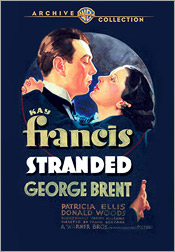
It's a romantic drama in which Francis and Brent portray a young couple whose future together is threatened by gangsters attempting to extort protection money from the Golden Gate Bridge construction that Brent is supervising. That part of the story is fairly formulaic with Barton MacLane in full voice as the chief racketeer. More interesting are the plot aspects stemming from Kay Francis's job as a worker with Travelers' Aid. Her job's importance is undervalued by Brent, but the reality is that she performs a vital service for many common folk such as an unwed mother, a destitute boy, giggling mail-order brides arriving from abroad, and young children traveling alone. The time capsule that the film provides in its presentation of these vignettes is a valuable window onto the late-depression era and that alone makes the film well worth viewing. Francis as usual gives a realistic and understated portrayal, and it's bracing when she pulls Brent's irons out of the fire in the film's climax. One's appreciation of Brent's work suffers just because his character is somewhat of a Neanderthal when it comes to the role of women, but the character redeems itself in the end. The whole thing whizzes by in a brisk 72 minutes and it's all nicely staged by director Frank Borzage. The Warner Archive release is presented full frame as originally shot. The image is quite sharp, bright, and has very good contrast. It tolerates viewing on large screens quite well. Speckles and scratches are quite apparent, but pose no real distraction. Modest grain is evident. The mono sound is strong and clear, despite some minor hiss. There are no supplements. Recommended. The desire for more Douglas Sirk on DVD seems to have been quite vocal for almost the entire DVD era. TCM in conjunction with Universal have recently responded with a four-disc set (Douglas Sirk: Filmmaker Collection) that includes four varied and previously unreleased titles. 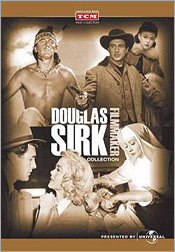
We get a murder mystery (1951's Thunder on the Hill), a western (1954's Taza, Son of Cochise), a costume adventure (1955's Captain Lightfoot), and a melodrama (1957's The Tarnished Angels). Thunder on the Hill is marginally the best of the four with The Tarnished Angels a well-acted but unpersuasive second, and Captain Lightfoot a close third. In Thunder on the Hill, Claudette Colbert plays Sister Mary, a nun at a convent that harbours various people sheltering from a flood. When a local dike collapses, all the inhabitants are isolated. Among them is a young woman (Ann Blyth) convicted of murder and on her way to the gallows. Sister Mary becomes convinced of the young woman's innocence and sets out to prove it despite the animosity of many in the convent. The film is a little-known entry on Colbert's impressive filmography, but it's hard to understand why. Perhaps that's been due to its general unavailability on home video to date. In any event, the film is an engrossing and sincerely told story that hides its resolution well for the first two-thirds of the film. Once it becomes obvious who the killer really is, the denouement is played out with style and suspense. Colbert as usual delivers a heartfelt and believable performance, but she's matched by a supporting cast that's lesser-known in general but all the more effective for that reason. Gladys Cooper (as the mother superior), Robert Douglas (as a doctor stranded at the convent), Michael Pate (as a mentally-challenged hospital worker), and Connie Gilchrist (as a helpful Sister) all stand out. The film is luminously photographed by William H. Daniels, but otherwise lacks the visual and emotional intense style that tended to characterize director Douglas Sirk's best-known films. The Tarnished Angels, from William Faulkner's novel "Pylon", was developed with Sirk's cast for Written on the Wind (made the year before) in mind (Rock Hudson, Robert Stack, Dorothy Malone). The film covers three days in the life of flying circus performers in Depression-era New Orleans, focusing on romantic complications that develop between a newspaper reporter (Hudson) and the aerial stuntwoman wife (Malone) of an airplane racer and ex-World War I fighter pilot (Stack). The situation is rife with the melodramatic themes that Sirk liked to pursue, and the film is full of emotionally charged and engaging moments, but the ending doesn't ring true and the whole seems less than the sum of the parts. One aspect that can't be denied is the excellence of the cast. The three stars are all impressive, but it's the work of supporting players such as Jack Carson and Robert Middleton that clinches the deal. Sirk filmed this one in black and white, which seemed to fit the mood and the era perfectly. The CinemaScope image is well used, particularly during the aircraft races around the pylons. Captain Lightfoot stars Rock Hudson as a dashing Irish outlaw who allies himself with famous rebel Captain Thunderbolt (Jeff Morrow) in the fight to overthrow the British Dragoons in early 19th century. The film is an exhilarating swashbuckler with a dash of tongue-in-cheek that is beautifully photographed in Ireland in CinemaScope and Technicolor. Hudson seems to be really enjoying himself in the film and it's a delight to see the great Jeff Morrow with a meaty role. Not to be taken too seriously, but good old-fashioned entertainment. Taza, Son of Cochise starts off with Jeff Chandler (playing Cochise for the third time) dying and passing the responsibility of guiding his people to his son Taza (Rock Hudson). That's the best part of the film, which otherwise is a pretty conventional western with a miscast Hudson and some gimmickry thrown in to capitalize on the 3D craze of the time. TCM/Universal's DVD release delivers each film on a separate disc housed in a digipak that strangely lacks a slipcase. Thunder on the Hill is full-frame as originally presented and looks quite sharp and clean. Contrast is excellent. Taza, Son of Cochise is given a 1.85:1 anamorphic transfer that is a little inconsistent. Some scenes are very sharp, while many others are soft. Colours are somewhat muted and appreciable grain is evident. Captain Lightfoot has a 2.35:1 anamorphic transfer that's quite impressive in terms of sharpness and colour brightness. The film exudes a warm look overall, but skin tones look a little red at times. The Tarnished Angels has a 2.35:1 anamorphic transfer that disappoints somewhat. The image is not particularly sharp and shadow detail is only average. (Be aware also that The Tarnished Angels disc lacked the last five minutes of the film when the DVD set was first released. This problem has now been corrected and replacement discs are available from TCM for anyone who may have gotten an early release version of the set.) The mono sound on all four discs is in good shape. Each disc contains an introduction by TCM's Robert Osborne, production information from the TCM database, and a selection of publicity posters, stills, and behind-the-scenes photos. A text biography of Douglas Sirk is also included on the Captain Lightfoot disc. Recommended. As the popularity of the traditional western waned in the 1ate 1960s and more and more such films were made overseas, a number of the westerns that were made in the U.S. focused on the final days of the west - the fencing-in of the land, the increasing influence of the railroad, the coming of civilization, and the gradual end of the heyday of the cowboy. Films such as Will Penny and The Wild Bunch dramatized various aspects of those final days, but none more effectively and lovingly than 1970's Monte Walsh. 
In his directorial debut, William Fraker crafted a wonderfully sympathetic portrait of the passing of the traditional cowboy job. Lee Marvin (Monte Walsh) and Jack Palance play a couple of aging cowboys and buddies who find that a long, hard winter has resulted in ranches being taking over by an eastern conglomerate interested only in the bottom line. A former rancher (Jim Davis) now working a much-reduced operation for the new eastern owners offers Marvin and Palance jobs, but even those are short-lived. Palance chooses to marry and take on running a store in town. Other out-of-work cowboys turn to rustling. Even Monte briefly considers work in a Wild West Show after proposing to his long-time mistress (Jeanne Moreau). (His eventual dismissal of the Wild West job is delivered in one of the film's most memorable lines, "I ain't spittin' on my whole life".) When Palance is gunned down, Marvin is left to avenge his death. There's an inevitability to all that happens in Monte Walsh, reinforced by the film's look of nostalgia created by its compositions that suggest the timeless art of Frederick Remington's western paintings. The acting is uniformly superb across the board, and Lee Marvin particularly has seldom been better. Jack Palance too is very effective, playing a gentle, almost reflective role that was atypical for him. The film is shot in Panavision and captures the wide-open spaces very effectively. A round-up of wild horses particularly benefits from the framing. Considering the empathy that director Fraker demonstrates for the subject of Monte Walsh, it's amazing that his only other western was the abominable The Legend of the Lone Ranger made a decade later. Monte Walsh was originally a Cinema Center Films production, now controlled by CBS Films, and released on DVD by Paramount. The 2.35:1 anamorphic transfer is very good. Colour brightness and fidelity are notable (bearing in mind the intended earth-tone focus), and interior scenes are particularly sharp. Exteriors are slightly weaker with grain being more noticeable during them. The mono sound is strong and consistent. The only supplement is a long and rather ragged theatrical trailer. Highly recommended. The winner of the first Berlin International Film Festival Golden Bear in 1951 has just been brought to DVD by VCI. It's a little-known Swiss-made film entitled Four in a Jeep, later released in the United States by United Artists. 
The title refers to the make-up of the military police patrols in post-World War II Vienna - one sergeant from each of the four occupying powers (United States, Russia, Britain, and France). One of these patrols becomes involved with a Viennese woman living in the Russian zone of the city who is awaiting the return of her husband from a Russian prison camp. The woman, Franziska (Viveca Lindfors), is harassed by local Russian authorities for reasons unknown to her and when the international patrol investigates, its American and Russian members (Ralph Meeker and Yoseph Yadin respectively) become directly involved with the fate of Franziska and her husband. Complicating their involvement is a previous personal relationship between the two men. Four in a Jeep of course puts one in mind of The Third Man because of the setting and time period. It doesn't nearly have the power and intrigue of the Carol Reed film, but Four in a Jeep does deliver a very atmospheric Cold War experience although the story in its original cut of 99 minutes as presented on the disc could have benefited from some judicious pruning. The later American release version was apparently 80 minutes and it would have been interesting to see if that tightened up the film effectively. Viveca Lindfors delivers a nicely controlled performance as Franziska and Yoseph Yadin does well as the Russian sergeant. Ralph Meeker as the American sergeant seems a little stiff at times in his first major film. Location filming was done in Austria including Vienna itself and the still-recovering city is very interesting to observe. Particularly effective is the moving sequence depicting the debarkation of returning prisoners of war from a train. VCI's DVD (a product of its arrangement with Kit Parker Films) is somewhat problematic. The full frame (as originally shot) image is not in great shape, suffering from poor shadow detail, wavering contrast, and plenty of scratches and debris. Viewing on medium to large screens is not advisable. The mono sound is also a problem, particularly in the first half of the film - muffled dialogue at times and varying volume level. Burnt-in English subtitles accompany much of the Austrian, French, and Russian parts of the dialogue. They are clear enough to read, but on larger screens some digital artifacting around them is quite evident. The supplements include a very interesting if somewhat disturbing quarter-hour short directed by Frank Capra (Your Job in Germany, 1945) that provides an uncompromising view of Germans that is intended to discourage any fraternization between occupying troops and German civilians. A few trailers for other VCI war-film DVDs round out the supplements. The quality of the DVD rules out a firm recommendation, but the film is worth a rental with the caution that the disc looks best on a small screen. One of the latest releases in VCI's line of "Best Of!" British Classics is Hell Is Sold Out. Starring Mai Zetterling, Herbert Lom, and Richard Attenborough, the 1951 film has an interesting premise. 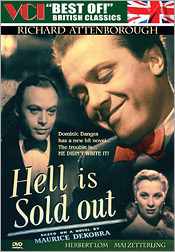
World famous French author Dominic Danges (Lom), who had been believed killed, returns home at the end of World War II after being imprisoned in a German Prisoner of War camp only to find a beautiful stranger (Zetterling) living in his home passing herself off as his wife. Moreover, she has written a novel called "Hell Is Sold Out" that is being passed off as a posthumous publication of Dominic's. For the sake of appearances and the future success of the novel, Dominic's publisher (Hermione Baddeley) convinces the pair to stay together. The truce only lasts a little while, though, and when Pierre Bonet (Attenborough), a prisoner buddy of Dominic's, resurfaces, the charade falls apart and Danges' "wife" moves into a room above the cafe where Pierre works as a pianist. One can guess how the rest of the story will play out and there's little that surprises in the end, but it's all done with drollness and in a classy production that leaves a good taste in the mouth. It's a little distracting to realize the British stars and supporting players are supposedly all playing French characters, but with the story mainly comprising interiors, you easily slip into thinking that much of it's taking place in an English manor house or publishing office and get caught up in the plot rather than being distracted by the English/French curiosity. The British stars are in good form and there's a fine array of British character actors including Baddeley, Kathleen Byron, Nicholas Hannen, Joan Hickson, and Olaf Pooley. It all adds up to an amiable timepasser for a rainy afternoon. VCI's full frame (as originally shot) transfer is a good one, holding up well when projected on a large screen. The black and white image is quite clear and offers very good contrast. Shadow detail is decent, but there are few dark sequences that would highlight any deficiencies anyway. A few speckles and scratches are apparent, but they're never a distraction. The mono sound is clear and virtually free of hiss. The only supplement is a publicity trailer for VCI's line of British DVD releases. Certainly recommended as a rental generally, and ardent fans of the three British stars will not likely be disappointed by a purchase. |
on to Page Two
 |
| Site
designed for 1024 x 768 resolution, using 16M colors and .gif 89a
animation. © 1997-2015 The Digital Bits, Inc., All Rights Reserved. billhunt@thedigitalbits.com |